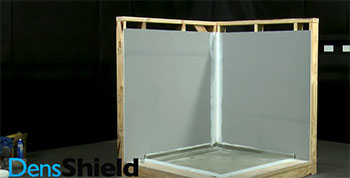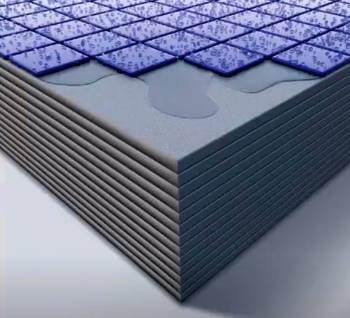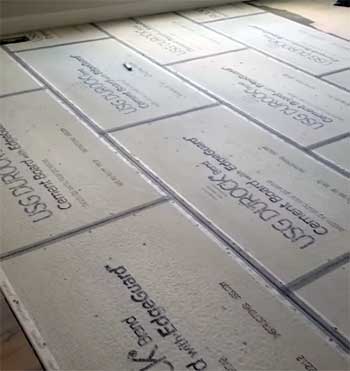I’ve spent years wrestling with tile backer boards in steamy shower stalls and humid bathrooms, and let me tell you, choosing the right one can make or break your project.
In this article, I’m comparing DensShield and Durock, two heavyweights in the tile backer world, to help you decide which is best for your next renovation.
I’ll break down their features, weigh their pros and cons, and share real-world insights from my own tiling adventures. By the end, you’ll know exactly which board suits your needs for a waterproof, durable shower setup.
A Brief Comparison Table
| Feature | DensShield | Durock |
| Material | Gypsum core with fiberglass mats and acrylic coating | Portland cement with fiberglass mesh |
| Weight (1/2″ sheet, 3×5 ft) | ~30 lbs (2 lbs/sq ft) | ~36 lbs (2.4 lbs/sq ft) |
| Thickness Options | 1/4″, 1/2″, 5/8″ | 1/4″, 1/2″, 5/8″ |
| Water Resistance | Built-in acrylic moisture barrier | Requires external waterproofing membrane |
| Mold Resistance | High (ASTM D3273 score of 10) | Moderate (relies on additives) |
| Ease of Cutting | Scores and snaps like drywall | Requires scoring or power tools, dusty |
| Installation | Uses drywall screws, lightweight | Needs cement board screws, heavier |
| Cost (3×5 ft sheet) | ~$12-$15 | ~$10-$12 |
| Best Use Case | Showers, bathrooms, humid areas | Showers, exterior projects, heavy-duty |
| Fire Rating | 5/8″ Type X available | 5/8″ Type X available |
My Journey With Tile Backer Boards
As a DIY enthusiast who’s tiled more bathrooms than I can count, I’ve had my fair share of battles with backer boards. I remember my first shower project: a cramped, humid bathroom in an old house where I was desperate to avoid mold and leaks.
The stakes were high—nobody wants to rip out a brand-new tile job because water sneaked through. That’s when I started researching DensShield and Durock, two names that kept popping up in forums, hardware stores, and contractor chats.
Both are designed to provide a solid, moisture-resistant base for tiles, but they’re as different as a hammer and a screwdriver. Let’s unpack what makes each one tick.
What Is DensShield?

DensShield, made by Georgia-Pacific, is a gypsum-based tile backer board with a twist.
Unlike traditional drywall, it’s got a water-resistant gypsum core sandwiched between fiberglass mats and topped with an acrylic coating that acts as a built-in moisture barrier.
This makes it a go-to for wet areas like showers, bathrooms, or even indoor pools. It’s marketed as a lightweight, easy-to-use alternative to cement boards, and after using it, I can vouch for its user-friendly vibe.
The first time I handled DensShield, I was amazed at how much it felt like working with drywall. You score it with a utility knife, snap it, and you’re good to go—no clouds of cement dust choking up your workspace. It comes in 1/4″, 1/2″, and 5/8″ thicknesses, with the 5/8″ version offering fire resistance for rated assemblies.
At about 2 pounds per square foot for a 1/2″ sheet, it’s noticeably lighter than its cement-based cousins, which is a blessing when you’re hauling it up a staircase.
Key Features of DensShield

Let’s break down what makes DensShield stand out. First, that acrylic coating is a game-changer.
It’s designed to stop moisture at the surface, meaning you don’t need to slap on an extra waterproofing membrane like RedGard or Kerdi in most cases.
I’ve used DensShield in a shower where the grout wasn’t perfectly sealed (my rookie mistake), and the board held up without a hint of mold or swelling after years of use.
Second, its mold resistance is top-notch. It scores a 10 on the ASTM D3273 test, which means no mold growth in a controlled lab setting. In my experience, this holds up in real-world bathrooms, especially in humid climates.
The lightweight design also makes it a breeze to install solo—I’ve hung 4×8 sheets in a shower stall without breaking my back.
Finally, DensShield’s versatility is a big plus. You can tile over it, paint it, or use it in non-wet areas without worrying about transitions to regular drywall. It’s like the Swiss Army knife of backer boards.
Pros of DensShield
I’ll be honest—DensShield won me over with its ease of use. Here are the main reasons why I keep it in my toolkit:
- Lightweight and Easy to Handle: At about 30 pounds for a 3×5-foot 1/2″ sheet, it’s a dream to carry and install, especially in tight spaces. I’ve done entire shower stalls without needing a second pair of hands.
- Built-in Moisture Barrier: The acrylic coating means you can skip the extra step of applying a liquid or sheet membrane in most cases. This saved me hours on a recent bathroom remodel.
- Clean Cutting: Scoring and snapping DensShield is as easy as cutting drywall. No special tools, no dust masks, no mess. I cut a whole bathroom’s worth of sheets in my garage without turning it into a dust storm.
- Mold Resistance: That ASTM D3273 score of 10 isn’t just marketing hype. I’ve used DensShield in humid basements and never seen a speck of mold.
- Versatility: You can use it for walls, floors, or even ceilings, and it’s paintable for non-tiled areas. I used it in a laundry room where only part of the wall was tiled, and the seamless transition to painted sections looked sharp.
- Cost-Effective for DIYers: At $12-$15 per 3×5 sheet, it’s slightly pricier than Durock but worth it for the time and hassle saved.
Cons of DensShield
Nothing’s perfect, and DensShield has its quirks:
- Not for Steam Showers: The manufacturer explicitly warns against using DensShield in steam showers due to its gypsum core. I learned this the hard way when a client asked for a steam setup, and I had to switch to cement board.
- Edge Sealing Required: The exposed edges need careful sealing with mesh tape and thinset to prevent water from reaching the gypsum core. I forgot this once and noticed slight swelling after a year.
- Less Durable for Heavy Impacts: While it’s fine for everyday use, DensShield’s gypsum core isn’t as tough as cement board. I dented a sheet when I dropped a hammer during installation.
- Limited Availability: In some areas, DensShield can be hard to find. I’ve driven across town to track it down when local stores only stocked cement boards.
What Is Durock?

Durock, produced by USG (the folks behind Sheetrock), is a cementitious backer unit (CBU) made from Portland cement, sand, and a fiberglass mesh that wraps around the edges for extra strength.
It’s the grizzled veteran of tile backers, built to withstand harsh conditions, from steamy showers to outdoor patios.
Available in 1/4″, 1/2″, and 5/8″ thicknesses, it’s a versatile choice for both interior and exterior projects.
My first encounter with Durock was a sweaty, dusty affair. Cutting it felt like wrestling a concrete block—scoring and snapping is possible, but it’s not clean, and the dust is no joke.
At about 2.4 pounds per square foot for a 1/2″ sheet, it’s heavier than DensShield, and you’ll need special cement board screws to secure it. But there’s something reassuring about its rock-solid feel, like it’s ready to take on anything water throws its way.
Key Features of Durock
Durock, on the other hand, is the tank of tile backers. Its cement core and fiberglass mesh make it incredibly durable, perfect for high-traffic showers or even outdoor applications like pool surrounds.
I once used Durock in a basement bathroom that flooded during a storm, and while the tiles took a beating, the board itself was unfazed.
Another standout feature is its adhesion. The rough surface of Durock grabs onto thinset mortar like nobody’s business, ensuring your tiles stay put. I’ve never had a tile pop off a Durock-backed wall, even in a busy family bathroom with kids splashing everywhere. It also meets ASTM C1325 and ANSI A118.9 standards, so you know it’s built to last.
However, Durock isn’t waterproof on its own. You’ll need a vapor barrier behind it or a waterproofing membrane on top, which adds a step to the installation process. But when done right, it’s a fortress against water damage.
Pros of Durock
Durock’s reputation as a workhorse is well-earned. Here’s why I respect it:
- Rock-Solid Durability: The cement core makes Durock nearly indestructible. I’ve used it in commercial bathrooms where it’s held up to years of heavy use.
- Superior Adhesion: The rough surface is a tile setter’s dream. Thinset bonds so well that tiles feel like they’re part of the board. I’ve done intricate mosaic patterns on Durock without a single slip.
- Versatile for Indoor and Outdoor Use: Unlike some backers, Durock can handle exterior projects like patios or pool surrounds. I used it for an outdoor kitchen backsplash, and it’s still flawless after three years.
- Widely Available: You’ll find Durock at every major hardware store, often in multiple sizes. No hunting required.
- Cost-Effective: At $10-$12 per 3×5 sheet, it’s one of the cheapest options for a reliable backer board.
Cons of Durock
Durock’s strengths come with trade-offs:
- Heavy and Cumbersome: At 36 pounds for a 3×5-foot 1/2″ sheet, it’s a beast to carry, especially up stairs or in tight spaces. My back still remembers hauling a dozen sheets for a big project.
- Messy to Cut: Cutting Durock is a dusty, gritty ordeal. Even with a good blade, it frays and leaves abrasive crumbs that can scratch tubs or floors. I always cut it outside now.
- Requires Waterproofing: Durock isn’t waterproof on its own, so you need a vapor barrier or membrane. This adds time and cost—I’ve spent extra hours applying RedGard to ensure a leak-proof setup.
- Special Fasteners Needed: You can’t just use drywall screws; Durock requires cement board screws, which aren’t cheap and have limited use elsewhere.
- Prone to Mold if Not Sealed: While it has some mold-resistant additives, Durock can still harbor mold if water gets through unsealed seams or screw holes. I’ve seen this in poorly installed showers.
Head-to-Head Comparison of DensShield And Durock
Let’s put these two in the ring and see how they stack up across key factors.

- Weight and Handling: DensShield is the clear winner here. At 2 pounds per square foot, it’s about 20% lighter than Durock’s 2.4 pounds. When I renovated my guest bathroom, I carried DensShield sheets solo, while Durock always had me calling a buddy for help. If you’re a DIYer working alone, DensShield’s lightweight nature is a lifesaver.
- Ease of Installation: DensShield feels like a cheat code for installation. You can use standard drywall screws, and it cuts cleanly with a utility knife. I installed a shower surround in a weekend with minimal fuss. Durock, on the other hand, demands cement board screws and a steady hand for cutting. It’s not impossible, but it’s slower and messier. If you’re new to tiling, DensShield will make you feel like a pro.
- Water Resistance: This is where things get interesting. DensShield’s built-in acrylic coating gives it an edge for standard showers, as it blocks moisture at the surface. I’ve used it in bathrooms with no additional membrane and never had issues. Durock, however, needs a vapor barrier or liquid membrane like RedGard to be fully waterproof. When I used Durock in a high-traffic shower, I spent extra time applying Kerdi to ensure no leaks. For steam showers, Durock is the only choice, as DensShield isn’t rated for that level of moisture.
- Mold Resistance: DensShield takes the crown with its ASTM D3273 score of 10, meaning no mold growth in lab tests. I’ve used it in humid climates and never seen a speck of mold. Durock relies on additives for mold resistance, but it’s not as robust. I’ve torn out old Durock installations where mold crept in due to poor sealing. If mold is your biggest worry, DensShield is the safer bet.
- Durability: Durock is the champ for raw strength. Its cement core can take a beating, making it ideal for commercial or high-traffic areas. I used Durock in a gym shower that sees dozens of users daily, and it’s still rock-solid. DensShield, with its gypsum core, is less durable against impacts. I once dented a DensShield sheet while moving tools, something Durock would’ve shrugged off.
- Cost and Availability: Durock is slightly cheaper at $10-$12 per 3×5 sheet compared to DensShield’s $12-$15. It’s also more widely available—I’ve never had trouble finding Durock at Home Depot or Lowe’s. DensShield can be trickier to source, especially in smaller towns. I once had to order it online, which delayed a project by a week. If budget and availability are key, Durock has the edge.
- Versatility: Durock’s ability to handle both indoor and outdoor projects gives it a slight advantage. I’ve used it for everything from shower walls to outdoor kitchen backsplashes. DensShield is fantastic for indoor wet areas and paintable surfaces, but it’s not rated for exterior use or steam showers. If your project involves varied environments, Durock is more flexible.
Real-World Scenarios: Which Board Wins?
Let’s talk practical applications. In my years of tiling, I’ve used both boards in different settings, and here’s how they perform.
- Small DIY Shower Project
For a small bathroom reno, like my guest bath last year, DensShield was a no-brainer. Its lightweight design and easy cutting made installation a breeze, and the built-in moisture barrier saved me from buying extra waterproofing.
The total cost was slightly higher than Durock, but the time saved was worth every penny. If you’re a DIYer tackling a shower or tub surround, DensShield will make your life easier.
- High-Traffic Commercial Bathroom
In a commercial project, like the gym shower I mentioned, Durock was the better choice. Its durability handled the constant use, and the rough surface ensured tiles stayed put under heavy wear.
The extra step of applying a waterproofing membrane was a hassle, but it was necessary for such a high-moisture environment. If you’re working on a space with lots of users, Durock’s toughness is unmatched.
- Steam Shower
For a steam shower, Durock is the only option. DensShield’s manufacturer clearly states it’s not suitable for steam environments, and I’ve seen gypsum-based boards fail in those conditions.
When I built a steam shower for a client, I used Durock with a Kerdi membrane, and it’s been flawless for years. If steam is in play, stick with Durock.
- Budget-Conscious Renovation
If you’re pinching pennies, Durock’s lower cost and wide availability make it the go-to. I used it in a rental property bathroom to keep costs down, and with proper waterproofing, it’s held up fine. DensShield’s slightly higher price and spotty availability can be a dealbreaker if you’re on a tight budget or timeline.
Installation Tips From the Trenches
No matter which board you choose, installation is where the rubber meets the road. Here are some tips I’ve learned the hard way:
- DensShield: Always seal the edges and screw holes with fiberglass mesh tape and thinset to keep water out of the gypsum core. I skipped this once, and the edges started to soften after a year. Use rust-resistant drywall screws and space them 6 inches apart for walls. If you’re tiling, apply thinset to the grey, acrylic-coated side for best adhesion.
- Durock: Invest in a good dust mask and cut outside—trust me, the dust is brutal. Use cement board screws, not drywall screws, to avoid corrosion. I’ve seen cheap screws rust and weaken the installation. Apply a waterproofing membrane like RedGard or Kerdi over the board, and don’t skimp on coverage. For extra protection, consider a vapor barrier behind the board, especially for exterior walls.
Frequently Asked Questions (FAQ)
It depends on your project. DensShield is easier to handle and has a built-in moisture barrier, making it great for DIY showers. Cement boards like Durock are more durable and better for steam showers or exterior use.
Yes, you can tile directly over DensShield’s acrylic-coated side using thinset mortar. Just ensure seams and screw holes are sealed with mesh tape and thinset.
Absolutely, DensShield is excellent for shower walls due to its built-in moisture barrier and mold resistance. Just don’t use it in steam showers.
There’s no one-size-fits-all answer. DensShield is ideal for DIYers and standard showers due to its ease of use and built-in barrier. Durock is better for heavy-duty or steam shower applications due to its durability.
My Final Take: Which Should You Choose?
After years of tiling, I’ve learned there’s no perfect backer board—it’s all about what your project demands. If you’re a DIYer like me, tackling a standard shower or bathroom, DensShield is your best friend. Its lightweight design, easy cutting, and built-in moisture barrier make it a dream to work with, saving you time and hassle.
But if you’re dealing with a steam shower, a commercial space, or an outdoor project, Durock’s durability and versatility are hard to beat, even if it means extra work with waterproofing.
You can’t go wrong with either, as long as you install them properly. Seal those seams, use the right screws, and add waterproofing where needed. Your shower will thank you with years of leak-free, mold-free performance.
So, grab your tools, pick your board, and get tiling—you’ve got this!
